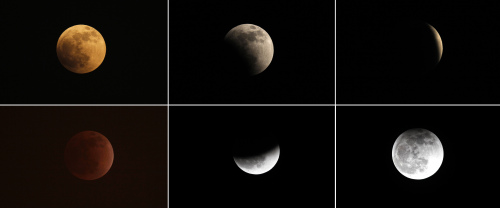SAN FRANCISCO (AP) _ Moon watchers in the western U.S., Hawaii, Australia and a large part of Asia were treated Saturday to a rare celestial phenomenon: a total lunar eclipse.
 |
In this combo made from six photographs, the different stages of a lunar eclipse as seen from New Delhi, India, Saturday, Dec. 10, 2011. (AP-Yonhap News) |
 |
A lunar eclipse is seen in the sky beside a statue of Buddha in Kurunegala, Sri Lanka, Saturday, Dec. 10, 2011. (AP-Yonhap News) |
 |
Chinese stargazers use a telescope to observe the moon during a lunar eclipse at the Planetarium in Beijing, China, Saturday, Dec. 10, 2011. It is the best view of a total lunar eclipse in 10 years in China, according to the China Astronomical Observatory. (AP-Yonhap News) |
For 51 minutes starting at 6:06 a.m. PST (1406 GMT), the Earth's shadow completely blocked the moon.
In the western U.S., the moon took on a reddish glow, as some indirect sunlight continued to reach it after passing through the Earth's atmosphere. Since the atmosphere scatters blue light, only red light strikes the moon, giving it a crimson hue.
The total eclipse was visible throughout Australia, Indonesia, southeast Asia, China, Japan, and a large swath of Russia east of the Ural Mountains.
David Sayre, who runs a public relations firm in Hawaii, said it had been cloudy and rainy around his house on Oahu, but the weather cleared just in time for the eclipse.
He awoke, as he usually does, around 3 a.m. and remembered to step outside the house in time to catch the eclipse about a half hour later. No one else in the neighborhood was up.
``Sure enough it was turning that orangy-red color,'' Sayre, 47, said. ``I said, `Gosh I better grab a camera.'''
He added, ``To be able to see it just right outside our house was really cool.''
At the Griffith Observatory in Los Angeles, some 300 people, many clutching coffee cups in the frigid morning air, sat with blankets and chairs on the observatory's great lawn.
Perched on a slope north of downtown near the Hollywood sign, the property offers clear views of the sky. Observatory officials alerted the crowd when the eclipse began and spontaneous applause erupted when the celestial event ended.
In China, stargazers observed the moon from the Planetarium in Beijing and had the best view of a total lunar eclipse in 10 years, according to the China Astronomical Observatory. In Australia, people watched the eclipse from telescopes at the Sydney Observatory.
A total lunar eclipse occurs when the moon goes through the long shadow cast by the Earth and is blocked from the sunlight that illuminates it.
The last total lunar eclipse was on June 15 although that was not visible from the U.S. The next one is on April 15, 2014, and will be seen in the U.S.










![[Today’s K-pop] Blackpink’s Jennie, Lisa invited to Coachella as solo acts](http://res.heraldm.com/phpwas/restmb_idxmake.php?idx=644&simg=/content/image/2024/11/21/20241121050099_0.jpg)